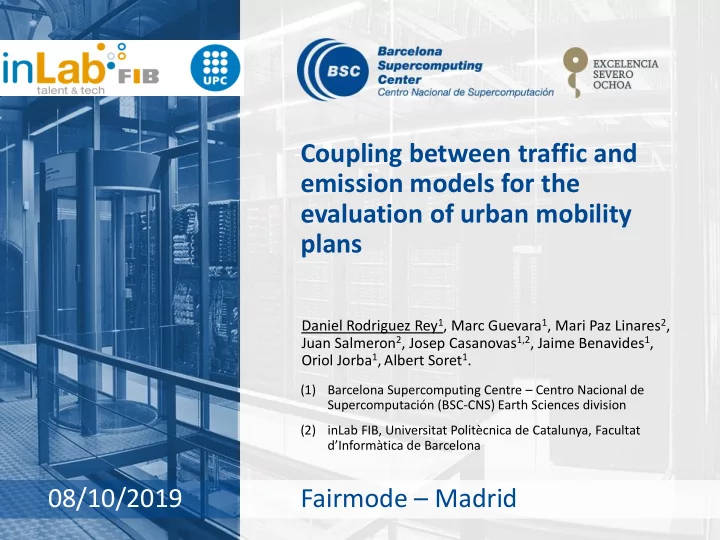

Coupling between traffic and emission models for the evaluation of urban mobility plans Daniel Rodriguez Rey 1 , Marc Guevara 1 , Mari Paz Linares 2 , Juan Salmeron 2 , Josep Casanovas 1,2 , Jaime Benavides 1 , Oriol Jorba 1 , Albert Soret 1 . (1) Barcelona Supercomputing Centre – Centro Nacional de Supercomputación (BSC-CNS) Earth Sciences division (2) inLab FIB, Universitat Politècnica de Catalunya, Facultat d’Informàtica de Barcelona 08/10/2019 Fairmode – Madrid
1 Need to in integrate mobilit ility and emiss issio ion models ls • Urban air quality problems mostly related to traffic. They can be tackled: • Technological policies: Euro classification program: Inefficient for NOx reduction in Diesel (Carslaw and Rhys-Tyler, 2013). • Reduction of VKT (vehicles kilometres travelled) by mobility plans: https://urbanaccessregulations.eu/userhome/map Which tools or methodologies should we use to evaluate urban mobility plans? Historic NO 2 measured levels in Barcelona (ASPB, 2018)
2 CALI CA LIOPE / / CA CALI LIOPE – Urb rban work rkfl flow Available at: VISUM www.bsc.es/caliope (Baldasano et al., HERMESv3 2008; Guevara et (emissions) al., 2013) WRF-CMAQ CALIOPE (mesoscale) (Baldasano et al., 2008) R-Line CALIOPE - Urban (urban scale) 445 Valencia St. (Benavides et al. 2019) (Snyder et al., 2013) CALIOPE-Urban NO 2 high-resolution (10m × 10m) concentration map. Benavides et al. (2019, Geosci. Model Dev.) Observed CALIOPE CALIOPE-Urban
3 The tr Th traffi fic sim simula lator • Origin Destination matrixes OD Zone B • Each path with difference impedance Zone A Traffic lights Vehicle flow Road capacity • Traffic assigment by an iterative process achieving user optimum. Network construction: • Network: Open Street Map data. • Private Tr. OD matrix data: GPS phone. • Public Tr. OD matrix data: GPS phone + public administration counting. • Calibration: 138 traffic flow data.
4 Vis isum network
5 Visu isum - HERMESv3 • High resolution emission modelling system • Emissions estimated at the source level combining state-of-the-art methodologies with local data and meteorology (Energy and manufacturing industries, residential and commercial combustion, agriculture, road transport, other mobile sources) • Road transport emissions • Street-level and vehicle-specific emissions • COPERT 5 + resuspension (Pay et al., 2011) • AADT (Annual Average Daily Traffic) VISUM • Traffic Network VISUM • Volume profile VISUM • Speed profile VISUM • Vehicle fleet • RSD study (RACC-AMB, 2017)
6 Su Superblo locs ide idea Aj. de Barcelona – “Pla d’Acció de l’àmbit de Superilles de St. Antoni.” December 2017 Street type to simulate
7 Superblo Su locks sc scenario io • Creation of a new road type: “Superblock”. • Max speed: 20 km/h • Link capacity: 5,250 vehicles/day • Estimated AADT: 3,000 to 8,000 vehicles. (action plan superilles: St. Antoni) • Vehicle demand (nº of trips) kept constant • Modification of the streets according to the reports of the city hall for each Superblock. Screenshot from Visum network Aj. de Barcelona – “Pla d’Acció de l’àmbit de Superilles de St. Antoni.” December 2017
8 Su Superblo locs sc scenario io result lts Superblock
9 Superblo Su locs sc scenario io result lts Superblocks Scenario: Hourly flow and NOx for principal roads 4,000 7.0 3,500 6.0 3,000 5.0 NOx [mol.h-1] 2,500 Nº VEHICLES 4.0 2,000 3.0 1,500 2.0 1,000 1.0 500 - - València C. Cent Viladomat GV (pl. Pere IV españa) Total Base (24h) 22.454 mol Nox AADT Base AADT Superblocks NOx base NOx Superblocks Total Superblocks (24h) 22.743 mol NOx
10 Dia iagonal l Tram pla lan Current disposition New Tram line Current Tram line Proposed disposition
11 Dia iagonal l Tram sc scenario io result lts Tram Scenario: Hourly flow and NOx for principal roads 9,000 12 8,000 10 7,000 6,000 8 NOx [mol.h-1] Nº VEHICLES 5,000 6 4,000 3,000 4 2,000 2 1,000 Total Base (24h) 11743 mol NOx - 0 Diagonal Diagonal Diagonal GV (Tetuan) Ronda de dalt Central Lateral out Lateral in Total Tram (24h) 11180 mol NOx AADT Base AADT Tram Nox base NOx TRAM
12 Tram+Superblo locks sc scenari rio result lts Tram+Superblocks Scenario: Hourly flow and NOx for principal roads 4,000 5 4.5 3,500 4 3,000 NOx [mol.h-1] 3.5 Nº VEHICLES 2,500 3 2,000 2.5 2 1,500 1.5 1,000 1 500 0.5 0 0 Diagonal Diagonal GV (pl. españa) C. Cent València Central Lateral out AADT Base AADT Tram + superblocks NOx Base NOx Tram + Superblocks Total Base (24h) 63274 mol NOx Total Tram+SB (24h) 64058 mol NOx
13 Futu ture work rk • Coupling the public transport network • Design and implementation of other mobility policies (congestion charge) • Air quality evaluation: • Mesoscale CALIOPE • Urban scale (CALIOPE – Urban) • Comparison between mesoscale (COPERT 5) and instantaneous (PHEMLight) emission models for hot spots (1second resolution)
Thank you for your attention Daniel Rodríguez Rey Barcelona Supercomputing Center Earth Sciences department daniel.rodriguez@bsc.es Acknowledgements : Daniel R. Rey work is funded with the grant BES-2016- 078116 from the FPI program by the Spanish Ministry of Economy and Competitiveness. Daniel developed part of this work at the inLab-Fib UPC research center and acknowledges their staff. 08/10/2019
Future work rk • Instantaneous emission models for hot spots AIMSUN PHEMLight Crossroad section, NOx, 24h NOx Emissions per second (PC Diesel Euro 3) 60 500 18000 7000 450 16000 6000 50 400 14000 350 5000 40 12000 NOx gpkm/h NOx (g/h) 300 Nº vehicles Speed (km/h) 4000 10000 30 250 8000 3000 200 20 6000 150 2000 100 4000 10 1000 50 2000 0 0 0 0 20 40 60 80 100 120 0 2 4 6 8 10 12 14 16 18 20 22 Time (s) NOx_PHEMLight Hour NOx_hermes speed Av. Speed Panis '06 Flow Hermes Flow PHEMLight PHEMlight COPERT IV & V
Future work • Congestion charge scenario • 𝐽𝑛𝑞𝑓𝑒𝑏𝑜𝑑𝑓 [𝑡] = 𝑈𝑑𝑣𝑠 + 𝑈𝑝𝑚𝑚_𝑈𝑏𝑦 • 𝑈𝑑𝑣𝑠 = 𝑈 0 ∗ (1 + 𝑏 · 𝑡𝑏𝑢 𝑐 ) Total travel time 2 € 0,005 €/𝑡 = 400 seconds • 𝑈𝑝𝑚𝑚_𝑈𝑏𝑦 𝑡 = ൗ +400 seconds
Recommend
More recommend